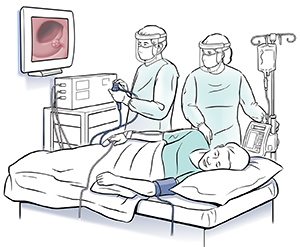Evaluating and Treating Rectal Bleeding
Evaluating and Treating Rectal Bleeding

Tests you may have
Any of these procedures may be done:
Stool sample. A small amount of your stool will be checked for blood.
Anoscopy. This test uses a small tube (anoscope) to examine the anus. It checks for problems such as hemorrhoids.
Sigmoidoscopy. This test uses a lighted tube to check your rectum and the part of the large intestine that is closest to the rectum (the sigmoid colon).
Colonoscopy. This test looks at your rectum and entire colon. You may be given medicine through an IV to help you relax.
Lower GI (gastrointestinal) series, or barium enema. This is an X-ray test to view your colon. A milky liquid containing barium is passed through your rectum and into the colon. This liquid makes it easy to see your colon on the X-ray.
Upper endoscopy. This test checks your esophagus, stomach, and upper small intestine. It is done in cases of rectal bleeding along with other symptoms like low blood pressure and rapid heartbeat. This test may also be done if your stools are dark black and tarry.
Capsule endoscopy. For this test, you swallow a pill that has a tiny camera inside. The camera takes pictures of your small intestine. It can get to areas that are hard to reach with colonoscopy and upper endoscopy.
Balloon enteroscopy. This test uses a special tube (scope) to get deep into the small intestine.
Tagged red blood cell scan. This test marks (tags) red blood cells with very small amounts of radioactive material. The cells can then be seen and tracked on a scan.
Angiography. This test threads a tube (catheter) through a vein, often in the leg. The tube injects dye into your blood vessels to see where the bleeding is taking place.
Your treatment plan
Your treatment will depend on the cause of your rectal bleeding. Your healthcare provider will create a treatment plan that’s right for you. Sometimes rectal bleeding stops on its own. If it does, be sure to see your provider to check that the problem wasn’t serious.
What you can do
Follow all your doctor’s instructions. Keep working with your doctor after your treatment. Make and keep your follow-up visits. If you have more rectal bleeding, call your doctor. It may be a sign of the same or another health problem.
Updated:
March 21, 2017
Sources:
Bernstein. CN. Workd Gastroenterology Organization Guidelines for the Diagnosis and Management of Inflammatory Bowel Disease in 2010. Inflammatory Bowel Disease (2010)l 16(1); pp. s112-s124
Reviewed By:
Fraser, Marianne, MSN, RN,Image reviewed by StayWell medical illustration team.,Lehrer, Jenifer, MD